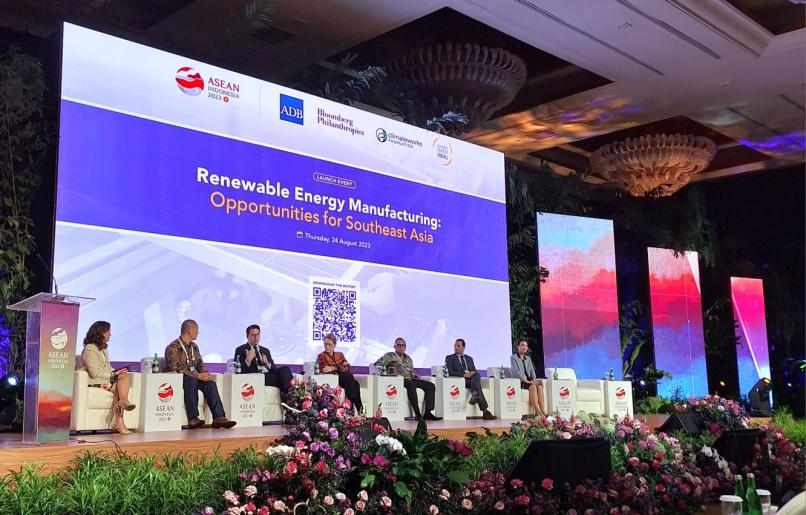Renewable energy manufacturing in Southeast Asia can generate USD 90 billion to USD 100 billion in sustainable revenue by 2030
The Southeast Asian region could lose up to 30 percent of its gross domestic product by 2050 due to increases in global temperature and extreme weather events, but bolstering the region’s renewable energy manufacturing capacity would position Southeast Asian countries to create new jobs and meet growing energy demand while drastically reducing emissions, according to new research released today on the sidelines of the ASEAN Finance Ministers and Central Bank Governors Meeting by the Asian Development Bank (ADB), Bloomberg Philanthropies, ClimateWorks Foundation, and Sustainable Energy for All (SEforALL).
Growing Southeast Asia’s solar photovoltaic (PV) cells, battery, and electric two-wheeler industries presents an estimated USD 90 billion to USD 100 billion revenue opportunity by 2030, with a potential 6 million renewable energy jobs to be created by 2050.
The new report, Renewable Energy Manufacturing: Opportunities for Southeast Asia, explores how to support the development of the clean energy manufacturing sector in Southeast Asia and help countries reap its immense economic potential while mitigating the impacts of climate change. Seizing this opportunity depends on government policy measures specific to each country in the region, including stimulating domestic renewable energy demand, ensuring cost competitiveness, improving the ease of doing business, and improving access to export markets. Collaboration at the regional level is also essential to provide further support through the deepening of intra-regional trade.
The report identifies potential ambition and outcomes for Southeast Asia to achieve the following:
- Grow solar PV manufacturing capacity in modules from 70 GW to 125–150 GW by 2030.
- Develop a regional battery manufacturing value chain, increasing national and regional demand, and establish Southeast Asia as a regional and global export hub, producing 140-180 gigawatt-hours (GWh) of battery cells by 2030.
- Expand assembly capacity for electric two-wheelers (E2W) in Southeast Asia from 1.4 to 1.6 million units annually to approximately 4 million units by 2030.
The report also highlights how Southeast Asia can build on its strong history of regional collaboration to enhance the competitiveness of its renewable energy industries and meet its Net Zero targets. For example, production factors could benefit from trade across the value chain and regional efforts to improve workforce quality and distribution. Demand markets could be supported by the build-out of the ASEAN Power Grid to enable higher renewables deployment through multilateral power trade and expanded grid balancing areas. Harmonization of technical standards for E2W vehicles and charging stations could enable original equipment manufacturers (OEMs) to develop products that suit needs across Southeast Asian markets.
Today's announcement builds on collaboration earlier this year between the African Climate Foundation, Bloomberg Philanthropies, ClimateWorks Foundation, and Sustainable Energy for All to publish Africa Renewable Energy Manufacturing: Opportunity and Advancement and launch the Africa Renewable Energy Manufacturing Initiative to drive investment and mobilize action with partner governments to scale up renewable energy manufacturing capabilities in African countries.
"As we often say in ADB, the battle against climate change will be won or lost in Asia and the Pacific. A decisive front in that battle is Southeast Asia. This research shows the promise of renewable energy manufacturing – with policy, technical, and financing support – in helping the region's developing countries to transition away from coal-based energy, while lowering carbon emissions, expanding local industrial capabilities, spurring job creation, and driving long-term economic growth."
Ramesh Subramaniam, Director General and Chief, Sectors Group, Asia and the Pacific, Asian Development Bank
“Southeast Asia has the potential to become a leader in renewable energy manufacturing to contribute to the global renewable energy deployment, while simultaneously achieving economic growth and mitigating the impacts of climate change. This report proves how increasing private sector investments into local renewable energy manufacturing sectors, strengthening regional value chain collaboration, and bringing together key stakeholders will create jobs, increase GDP, and help Southeast Asian nations meet their climate goals."
Antha Williams, Environment Program, Bloomberg Philanthropies
“The clean energy industry is already a massive growth opportunity, and will need to scale even more rapidly for us to achieve carbon neutrality globally by 2050. Southeast Asia, which is home to one-fourth of the world's population, is well positioned to become a global leader in renewable energy manufacturing with its vibrant business environment and large talent pool. In doing so, the region can boost the supply of affordable and reliable renewable energy solutions to people and communities in Southeast Asia and around the world, and create new job opportunities locally.”
Helen Mountford, President and CEO, ClimateWorks Foundation
“By growing their renewable energy manufacturing capabilities, Southeast Asian countries can increase GDP, create jobs and decarbonize energy systems, contributing to both economic growth and climate progress. This report highlights how countries within the region can establish strong, local industries that will contribute to a prosperous and sustainable future."
Damilola Ogunbiyi, CEO and Special Representative of the UN Secretary-General for Sustainable Energy for All, and Co-Chair of UN-Energy
